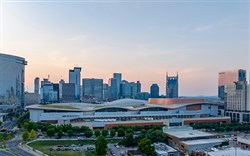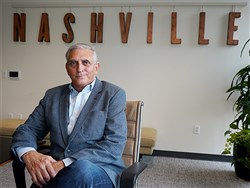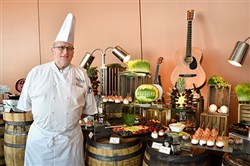VOL. 47 | NO. 25 | Friday, June 16, 2023
The skeptics had it wrong
By Tom Wood
A chuckle is the initial response from Charles Starks when asked if the Music City Center has been more successful than he could have imagined. Then the president and CEO of the massive downtown facility settles into his chair and reveals the moment he knew that one of the most controversial buildings in Nashville history would someday be hailed as a landmark achievement.
That day’s arrived. The Music City Center is celebrating its 10th anniversary with an enviable record. Despite a 15-month COVID-19 closure, the Center has:
• Hosted 2,335 events, including 462 local nonprofit events
• Played host to 4.4 million people
• Had a $3.3 billion direct economic impact for the Nashville area
• Received multiple industry awards, including the 2023 Smart Stars Award for Best Convention Center from smartmeetings.com and 2017’s Venue of Excellence by the International Association of Venue Managers, plus awards for design and sustainability
Starks recalls a June 2008 convention-recruiting trip with then-mayor Karl Dean that made him “believe this is going to do what we say it’s going to do. We took him on a trip to Orlando to convince a group of dentists to bring their meeting to Nashville – and this is before we had approval to build it.
“He gets up and says, ‘We want you to come to Nashville, Tennessee. Come to a convention center that – on land we do not own, that has no approved funding plan in place and has yet to be fully designed – but here’s what we want you to do.’ We got people to buy that idea because they saw the value in coming to Nashville.”
Five years later, in June 2013, the Academy of General Dentistry became a historic footnote as Music City Center’s first national convention.

It’s hard to imagine the 2.1 million-square-foot Music City Center being any larger than it is. But it was built to allow for the addition of two levels.
-- Photo By Ed Rode | The Ledger“So, the answer is yeah, I believed we could be highly successful. Did I believe we could be this highly successful? No, I didn’t see that.” Starks laughs again. “If I had, I’d have bought some land downtown and I’d be retired somewhere.”
And how does that success bode for Nashville’s newest controversial project, an enclosed stadium to replace Nissan Stadium with surrounding development, which Starks describes as “the next Music City Center for the city.”
“All the folks that are doubting the stadium and what its ability is, I predict that 10 years after that thing’s open, they’re going to look back and say how in the world did we not know to build that stadium? Why was there ever a question about it?” Starks says.
“And then what’s going to happen on the East Bank is we’re going to have a desirable downtown. There’s some of these great cities in the United States … their downtown is not that desirable.
“That’s why we’re seeing so much vertical growth in downtown Nashville … it’s because people want to live down here. They want to live, work and play downtown. So we’ve got that working for us. And I don’t see that slowing down.”
Plaudits from CMA, NASCAR
Since the May 2013 opening, Music City Center has hosted everything from huge business conventions to small Nashville nonprofit gatherings; from thousands of CMA Fest attendees last week to those who attended NASCAR’s annual awards banquet last December. There have been comic conventions, sports festivals, proms, religious conventions and so many more unique events.
“We’re one of these venues that – regardless of what your interests are – we’re going to eventually have something here that pertains to everybody’s interest,” Starks says.
Sarah Trahern, CEO of the Country Music Association, says the Music City Center is a valuable partner in staging the weeklong CMA Fest each June that attracts thousands and last year generated an estimated $65.2 million in direct visitor spending.
“Each year, we host Fan Fair X inside Music City Center during CMA Fest. Fans can find everything from celebrity panels, an acoustic stage, vendors, games, partner activations and, most importantly, meet-and-greets with artists,” Trahern says.
“When Fan Fair began in 1972, it was truly an event for artists to show their appreciation to the fans, to get up-close-and-personal with their favorite acts. The Music City Center location allows us to continue that tradition.
“Given that our event takes place in June, having an indoor location within our festival footprint offers our attendees a great opportunity to escape the heat and enjoy programming at the same time. … Having access to the convention center has been a factor to the event’s success and ultimately, its expansion over the years.”
Matt Greci, Speedway Motorsports senior vice president and Nashville Superspeedway general manager, says he appreciates the growing relationship with Nashville in general and the Music City Center in particular.
“The Music City Center is a tremendous building. It’s a great asset for the city,” Greci says. “It has brought in great events. Anything we can partner with them on and continue our growth is very important to us.”
Pros outweigh cons
Longtime Nashvillians might remember the rancor in the early years of this century that surrounded the proposed building of the Music City Center, a massive downtown facility that would replace the outdated and outgrown Nashville Convention Center. Starks does.
“We had people that said this sounds like a bad idea, it will never pay for itself. It’ll never do what you’re saying it’s going to do,” says Starks, who previously had been with Gaylord Opryland Hotel and Convention Center.
“You had those folks that could see the vision for it and understand that we really were not competing for national conventions at the old convention center. But most Nashvillians were pretty skeptical.”

Butch Spyridon says working to get Music City Center built was one of his toughest fights.
Butch Spyridon, the soon-retiring CEO of the Nashville Convention & Visitors Corp., has even longer memories of the sometimes-acrimonious struggle to get the Music City Center built. He says the first conversations came up with former mayor Bill Purcell in 1999.
“Maybe the toughest fight, argument, effort, whatever the word, that I have ever experienced. To get all the way to 2013 before it opened was quite the journey,” he recalls. “I find it kind of gratifying, but I can’t really find the critics anymore. They were so loud (and) boisterous … Nashville’s not a destination. Conventions are dying. The city is going to have to bail this building out. Those were three main arguments that we had to listen to and defend.
“Well, I can tell you that we’re now the second-most successful destination in the country, according to one of the major third parties. The conventions are not dying. We’ve moved into the Top 10, Top five for the last several years. The center has bailed the city out rather than the other way around. And to say Nashville’s not a destination … I don’t think you have to look very far out the window.
“So, a little bit of – not a rant but a little bit of a soliloquy – to say the building has been an enormous success. Nashville is now a global destination and providing revenue to help fund city needs on a one-off basis. So win, win, win.”
By the numbers
Just how big is the Music City Center and how much did it cost? Here are some eye-opening fun facts and figures:
• It’s a 2.1 million square foot facility with more than 353,000 square feet of exhibit hall space
• Two spacious ballrooms (57,500 and 18,000 square feet)
• As many as 60 meeting rooms

The 2013 ribbon-cutting ceremony at Music City Center.
-- Photograph Provided• A covered parking garage with 1,800 spaces
• A loading dock with 62 bays.
But wait, there’s more, gleaned from the Clark Construction website:
• The four-acre, undulating green roof is the largest such in the Southeast and has 175,000 square feet of rooftop vegetation
• The 14-story glass curtain wall system in both the concourse and exhibit halls allows for natural lighting.
• $2 million of public art, with eight large-scale commissioned works and 62 acquired from local artists.
What the public doesn’t see are the 60 air handling units, 8 electrical substations, 2 generators, more than 2.5 million feet of conduit, 60 miles of piping and 2.3 million pounds of sheet metal.
Added up, the total price tag was $623 million.
“The building sits on about 18 acres of land, and our total costs – not including the issuance of the bonds; that’s actual construction, land and soft costs and all – was almost $585 million,” Starks says. “The actual debt on the building is about $635 million by the time you issue the bond debt and all the work and the reserves you have put in place.
“Today, the building’s valued over $1 billion.”
He notes that the building is operated by the Convention Center Authority, meaning that “while there are some additional taxes that were added on visitors that come to us, we have to live within our means. We don’t get any money from the state. We don’t get money from the city. We’ve got to take the tax streams that were set up for us, the operating revenues that we generate.”
While many convention centers lose money, Starks explains, Nashville’s does not.
“And if we have an operating loss – the only year we’ve had an operating loss was during COVID – we’ve got to be able to pay for that.
“If that happens, we’ve got to be able to pay for all of our capital expenses. If we need to buy new carpets, it’s our job to pay for them.
“Then, in turn, we’ve been able to partner with the city and do many other things here to the tune of over $150 million that we’ve contributed back to various programs, departments and things to help the city and community. We’re proud of that.”
Four-star food key to success

Award-winning executive chef Max Knoepfel is responsible for feeding 600,000 visitors annually.
-- Photograph ProvidedAnother important facet to the success of the Center is its award-winning culinary team led by executive chef Max Knoepfel since it opened. Knoepfel was recently honored as one of nine recipients of the 2023 International Foodservice Manufacturers Association Silver Plate Award. The coveted award recognizes extraordinary operator executives in various food service categories.
“I’m humbled and ecstatic by this honor. So many great hospitality leaders have won this award,” Knoepfel said. “I look forward to many more years of being a good steward of the industry.”
Responsible for feeding 600,000 visitors annually, gourmet meals aren’t the only things served during conventions. Over the past decade, the staff has provided 770,669 continental breakfasts, 184,270 boxed meals and 108,074 gallons of coffee (excluding coffee served with meals).
“We put a great emphasis on food and beverage. While lots of people say, ‘well, convention center food this or stadium food that,’ we don’t believe in that. I’ll put our food program against any hotel in the city any day, whether it’s small or large.” Starks says.
“We’re proud of the fact that we sell more food and beverage per square foot than any building in the country.”
‘Civic furniture’ a team effort
Spyridon credits a symbiotic relationship between organizations, downtown business leaders, government agencies and the airport authority for the unparalleled growth of Nashville’s downtown campus in the last couple of decades.
To be fair, not everyone sees the boomtown development as success. History is being replaced by high-rises and tall-skinnies are replacing homes. Traffic is worse, and affordable housing and infrastructure improvements are lacking.
The East Bank of the Cumberland River will be the next domino when Nissan Stadium is replaced by a $2.1 billion enclosed stadium and that area is redeveloped.
“We have been very intentional from the beginning. City leaders were thoughtful,” Spyridon says. “I think (former mayor Phil) Bredesen may have (said) ‘civic furniture,’ that if we put them strategically placed next to each other, we’re not trying to develop a neighborhood, that we’re going to get that benefit out of the stadium, but the stadium, the arena, the Convention Center and even the Symphony Hall and some of the attractions.
“We have the best footprint for large events in the country. We have hotels, attractions, restaurants, music and infrastructure all within a half-mile of each other. So with all these facilities, you don’t need shuttle buses here.
“You maximize spending and you make it convenient, which means it’s a little cheaper for some of these conventions and events to use Nashville as opposed to another city. A lot of cities do it well. Very few cities have the compact, complete campus that we will have – and I say complete now with the stadium coming on board.”
Nashville’s hotel and business growth has paralleled that of the Music City Center.
“As we celebrate the remarkable 10-year journey of the Music City Center, it’s important for the business community to reflect on the transformative impact it has had on Nashville,” says Jeff Hite, chief economic development officer for the Nashville Chamber of Commerce.
“This iconic venue has not only elevated our status as a global music and meeting destination but has also catalyzed tremendous economic growth and community development.”
Leesa LeClaire, president and CEO of the Greater Nashville Hospitality Association, lauds both the CMA and the Music City Center for their roles in her industry’s growth.
“It is important to have a diverse offering of music, with a variety of music venues that attract different types of entertainment and thus audiences. Our Music City Center can host events like local charitable breakfasts and proms to large and small conventions and groups,” LeClaire says.
LeClaire notes that 1,000 rooms were added to the Nashville portfolio over the last year with more on the way. She says there are 60 hotels and 8,901 rooms in various Davidson County pipeline phases – 14 hotels (2,180 rooms) under construction, with 20 hotels (3,707 rooms) in final planning and 26 hotels (3,014 rooms) in the planning stage.
“The hospitality industry is a major economic force for our area,” LeClaire says, a point that Starks reiterates.
“We in the hospitality community can have disagreements or different thought processes. But at the end of the day, everybody kind of puts their hand in the middle like a huddle and says, you know, ‘OK, you know, we’re going to run this play on three, let’s go. And everybody says, ‘OK, let’s go run the play.’
“We’ve got a teamwork atmosphere in Nashville, in the hospitality community, that is just not as prevalent in most cities – in any cities we compete with that I’m aware of. And we really do that well here.”